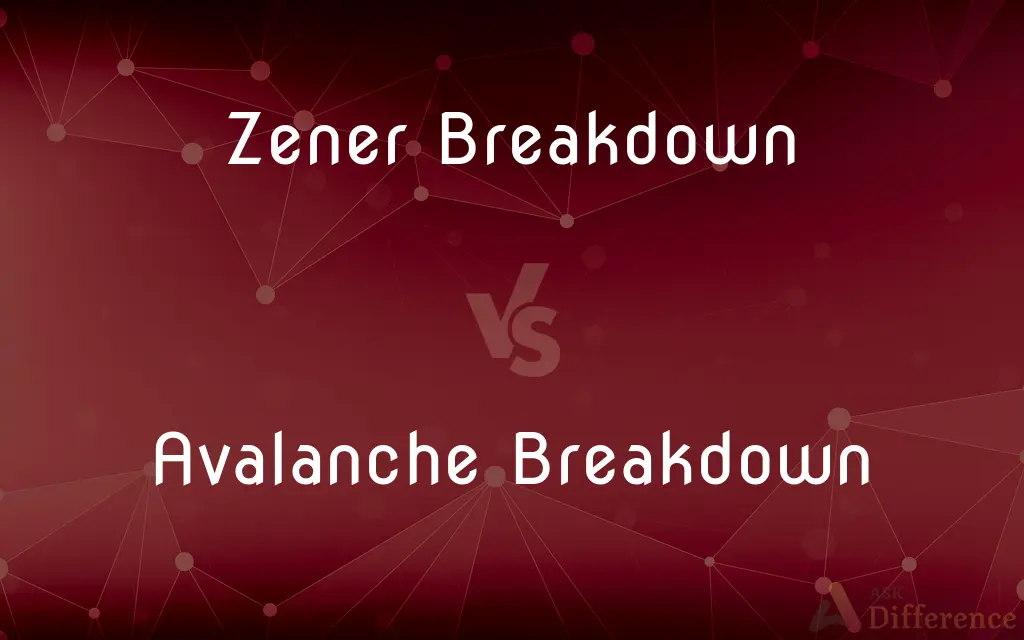Zener Breakdown vs. Avalanche Breakdown — What's the Difference?
By Tayyaba Rehman — Published on January 16, 2024
Zener breakdown occurs due to high electric field across a pn-junction, causing electron tunneling; avalanche breakdown results from collisional ionization.

Difference Between Zener Breakdown and Avalanche Breakdown
Table of Contents
ADVERTISEMENT
Key Differences
Zener Breakdown is observed in semiconductor diodes that are subjected to high electric fields, typically in diodes with a heavily doped pn-junction. When the electric field is strong enough, it can break covalent bonds, generating electron-hole pairs. This effect is relatively voltage-specific and can occur at lower reverse bias voltages.
Avalanche Breakdown, on the other hand, occurs in less heavily doped diodes at higher reverse bias voltages than Zener Breakdown. It involves a chain reaction where free electrons gain enough kinetic energy from the electric field to create additional electron-hole pairs through collisions.
In Zener Breakdown, the electric field is so strong that it allows electrons to tunnel through the energy barrier of the depleted region. This tunneling effect is a quantum mechanical phenomenon and leads to a sharp increase in current at a certain reverse bias voltage known as the Zener voltage.
Avalanche Breakdown is not a quantum mechanical effect but a result of cumulative energy gain. The electrons accelerated by the electric field collide with semiconductor atoms, knocking off more electrons and leading to an avalanche of carriers, which significantly increases the current.
Both phenomena are used to advantage in different types of semiconductor devices. Zener diodes exploit the Zener Breakdown to regulate voltage in circuits, while Avalanche diodes are used where higher breakdown voltages are required.
ADVERTISEMENT
Comparison Chart
Voltage Range
Occurs at lower reverse bias voltages.
Occurs at higher reverse bias voltages.
Doping Concentration
High doping concentration.
Low to moderate doping concentration.
Mechanism
Electron tunneling through depletion zone.
Collisional ionization and carrier multiplication.
Dependence on Temperature
More temperature dependent.
Less temperature dependent.
Use in Devices
Used in voltage regulation (Zener diodes).
Used in devices needing higher voltage handling.
Compare with Definitions
Zener Breakdown
Specific voltage-triggered conduction in diodes.
At a critical reverse bias, Zener breakdown occurs, stabilizing the voltage across the load.
Avalanche Breakdown
Electron collision causing a large increase in current.
The avalanche breakdown unexpectedly triggered a current spike in the power supply.
Zener Breakdown
Electron tunneling in heavily doped diodes.
Zener breakdown allows for precise voltage clamping in electronic components.
Avalanche Breakdown
A chain reaction of ionization in semiconductors.
The device failed when it underwent avalanche breakdown due to a surge.
Zener Breakdown
Voltage-specific diode breakdown mechanism.
The diode experienced Zener breakdown, which prevented voltage spikes in the system.
Avalanche Breakdown
Collision-induced carrier multiplication in diodes.
An avalanche breakdown can destroy a transistor if the voltage exceeds its maximum ratings.
Zener Breakdown
Voltage regulation via electron tunneling.
The Zener diode protects the circuit by undergoing Zener breakdown at 5 volts.
Avalanche Breakdown
Breakdown due to high kinetic energy of electrons.
At high voltages, the diode is designed to enter avalanche breakdown to absorb the excess energy.
Zener Breakdown
Controlled breakdown in semiconductors for regulation.
Through Zener breakdown, the circuit maintains a constant voltage despite fluctuations.
Avalanche Breakdown
High-voltage-triggered breakdown in lightly doped diodes.
Avalanche breakdown in the diode begins when the reverse bias voltage is too high.
Common Curiosities
How does temperature affect Zener Breakdown?
Zener voltage decreases with an increase in temperature.
At what voltage does Avalanche Breakdown occur?
It varies by diode but occurs at higher voltages compared to Zener Breakdown.
Is Zener Breakdown reversible?
Yes, if the diode is not overheated, it can revert back to normal operation.
How does one protect circuits from unintentional Avalanche Breakdown?
By using components that can handle expected voltages and by adding protective elements.
Can Avalanche Breakdown be used intentionally in circuits?
Yes, Avalanche diodes are designed to operate in avalanche mode for certain applications.
What causes Zener Breakdown?
Zener Breakdown is caused by a strong electric field inducing electron tunneling.
Are Zener and Avalanche Breakdown dependent on the material of the diode?
Yes, different semiconductor materials affect the breakdown characteristics.
What is the main application of Zener Breakdown?
Voltage regulation and reference in electronic circuits.
How is Avalanche Breakdown different from Zener Breakdown?
Avalanche Breakdown results from collisional ionization, not electron tunneling.
Does Avalanche Breakdown require a specific type of diode?
Yes, diodes designed to handle avalanche conditions are used.
Can Zener Breakdown occur in any diode?
No, only in specially designed Zener diodes with heavy doping.
What happens to the current during Zener Breakdown?
It increases sharply once the Zener voltage is reached.
Is Avalanche Breakdown destructive?
It can be, if the diode is not rated for the resulting current.
Do Zener diodes always operate in the breakdown region?
No, only when the applied reverse bias voltage exceeds the Zener voltage.
Can Zener Breakdown be observed at zero temperature?
In theory, yes, because it's a quantum mechanical effect, but practically, it's observed at operational temperatures.
Share Your Discovery

Previous Comparison
Acetyl CoA vs. Acyl CoA
Next Comparison
Sterling Silver vs. Stainless SteelAuthor Spotlight
Written by
Tayyaba RehmanTayyaba Rehman is a distinguished writer, currently serving as a primary contributor to askdifference.com. As a researcher in semantics and etymology, Tayyaba's passion for the complexity of languages and their distinctions has found a perfect home on the platform. Tayyaba delves into the intricacies of language, distinguishing between commonly confused words and phrases, thereby providing clarity for readers worldwide.
















































